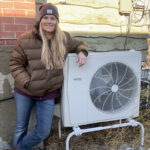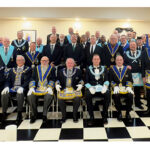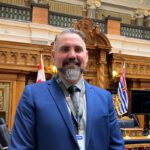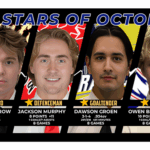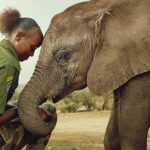Home »

I love Jumbo wild: Arnor Larson
By Robyn Duncan
Arnor Larson is the kind of man you take seriously. And you should.

His years of mountain guiding, extreme attention to detail and proficiency with most everything he does leaves you feeling very confident to just follow his lead. Based in the small community of Wilmer, nestled beside the Columbia River Wetlands, Arnor has devoted countless months of his life in recent years to fight the proposed Jumbo Glacier Resort. Though he often flies under the radar, Arnor is an example of the grassroots strength that has propelled this campaign for 25 years.
Clichés are clichés for a reason, and when it comes to Jumbo, the devil truly is in the details.
The success of the 25-year struggle to keep it wild has been thanks in large part due to details and an uncanny focus on these details. Arnor set his focus on two aspects: the Farnham Glacier License of Occupation and the Environmental Certificate. His research and analysis is the stuff theses are made of and his work played a critical role in exposing fatal flaws of the JGR as it moved forward.
Certain projects in B.C. need to undergo an environmental assessment, after which, if you’re successful (and they’re basically all successfully passed – read the Auditor General’s scathing report here on the BC EA process), you’re granted an Environmental Certificate (EC) for a term of five years, renewable for one five-year term. By the end of this term, you need to have substantially commenced the project.
The EC for the JGR was issued in 2004, along with 200 legally-binding conditions that had to be met or followed during project construction. As we neared the expiration, due diligence and Arnor’s incredible attention to detail, helped us to document the state of construction (or lack thereof) that ultimately led to the cancellation of their EC in June 2015. Arnor’s work was backed by a team of dedicated and passionate volunteers, many of whom spent days and weeks at the Jumbo Monitoring Camp, documenting construction activity for the record.
I sat down with Arnor in his home this spring and left three hours later full of stories, laughter and respect for this champion of the Purcells. It is with pleasure that I invite you to meet Arnor.
Robyn Duncan, Jumbo Wild: My first question is just how you ended up here in the Purcells?
Arnor Larson: Well, I came to Canada in 1968 because there was a little thing called the draft in the United States. I didn’t want to go to jail and I didn’t want to go kill women and children over on Vietnam so I came up in 1968. I was in Alberta for a few years and myself and my wife, who I’d met in college, came to B.C. in 1971. I became involved fairly early on in environmental things. I remember going to an event in Golden where I met John (Bergenske).
I’ve always been involved in conservation but not in an aggressive way. I’ve also been disillusioned with governments and what you can accomplish with them. My participation in the Jumbo thing… I was there—I’ve a copy of the very first 1991 document that they put out and shortly after that there was a meeting at the Invermere curling rink to establish what became the Jumbo Creek Conservation Society. I also spoke at the very first public event that was held at the community hall. I think I sent you a couple of documents on that, didn’t I?
R: Yeah, I think you did.
A: That was just to remind people about the question of the spiritual value of places; everybody has a spiritual connection with the mountains. It’s not a grizzly bear spirit for me, but it’s just the feelings, the quiet, and the contemplation that can take place in that environment that you just can’t find down in a humdrum busy city. It’s a much better direction to go into the Purcells than to go over to Calgary. Yet, most people would prefer to go to Calgary, apparently (laughs). So, that went on over a number of years but it was the same thing. It was sort of here a little bit but then nothing happens and then there a little bit and then nothing happens, until 2008. At the time I was in the mountains in a different location with my telescopes—I do a lot of astronomy and photography as well—and when I came down, I got a call from Gerry saying that Meredith and company had already established a—what should we call it?
R: A camp?
A: A camp. A checkpoint… because they weren’t blockading—only those who would do an illegal activity would be stopped. They never came back after we established the camp. Anyway, before I went up to the checkpoint camp the first time, I said, heck, if I go out there, I don’t like this driving back and forth. I’ll go out there for eight days and take my camera. Altogether, considering the fact that as you get towards the end of an event, it’s harder and harder to find people willing to staff a camp, I did two eight day stints in a row, just came down for an evening meeting and went right back up. So all in all, I spent 27 days up Farnham Creek in 2008, which I believe is more than anybody else did that year.
R: And that was for six weeks or eight weeks? I’m just trying to remember…
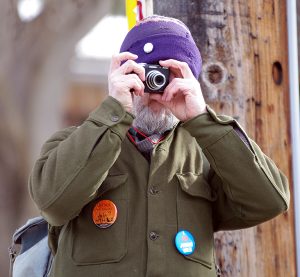
A: It was nearly two months, I can’t remember the exact number, but it went well into September. So, that was an interesting taste. I immediately sensed that we needed to have better documentation of what was going on. After some insistence from Meredith, I took her digital camera (I’d never used a digital camera before) and went up above to spend a whole day documenting a bulldozer track up to the West Farnham Glacier and all the stuff around the huts, fuel spills and stuff like that. And so, I was even more inclined to follow up on that because I had that initial record. When I got back down I ended up buying myself a digital camera, which is sad, but probably good, because now it’s next to impossible to get good quality film and proper processing. I do my own black and white processing, but I don’t do colour. And so, I went up again very early in June of 2009 to see what things looked like after the winter. There’s still a lot of snow there in June, but it was clear enough at the fuel tanks to see that one of them was leaking, drip drip drip drip, and we didn’t know how long it had been doing that. There was no sign of anyone else having been up there; we were pretty sure we were the first people up that spring. That’s when I decided, well, I’ve never had much faith in governments and bureaucracies, but I asked around about who I should send a letter (regarding the fuel spill) to, such as the Ministry of the Environment, and then… I can’t even remember the name of the Ministries at that point in time—
R: There’s been so many on this file!
A: And the other was the Lands branch or something like that. Anyway, I sent a letter with photographs, and these were actual photographs in an envelope and sent registered mail. You know, you get back a little printed note saying, ‘We appreciate your interest in this subject and we will take it under advisement’ or something, which means (laughs) that nothing is going to happen. So, that was with regard to the fuel spill. I thought somebody should be sent up there to look into it. I thought, maybe I’m wrong and there is no concern, but nevertheless it should be checked out, because it’s near water and all that sort of thing. So, later in that summer, in August, I went up there again and walked for probably my third time up the bulldozer track to the West Farnham Glacier. I was shocked to see the amount of erosion that had occurred where the creek crosses that bulldozer track. So I took more photos and I—at this point in time, who was it? Heather Leschied said, “well Arnor you should send this stuff by email.” And I said “sure… well show me how to do it.”
So I actually sent some stuff from her office for a while until I figured out how to do it. And so I sent those pictures and I said to the government people, well, look! The ‘window’ is excellent to get up there right now. The glacier skiing with the snow-cats was going to start mid-September, the roads are open, get an inspector up there and look at these things: the fuel spill and so on. And so I went up several more times, in August and September and I sent more pictures of the erosion continuing to take place. You know, they all think that the erosion only comes in the spring when the freshet occurs. Well surprise, surprise, just above that point is a glacier, and on the sunny September afternoons, more snow pack was coming down off the glacier than there was in July. And the erosion was getting worse and worse, and I kept sending them pictures. In October, I told the government, ‘This is your last chance this season.’ As expected, nothing happened. It was ridiculous. So that was 2009 and I think it was that year that we were concerned that something else might happen up Farnham and we got a call in late November, early December that someone had heard on the two-way radio on Horsethief Creek a mention about something going up to Farnham and so on. I was really surprised. I took my little Nissan truck, drove up Farnham and I got to the gate (where the camp spot was in 2008) on December 3, 2009. But, there was nothing, nobody was doing anything. So somebody had misinterpreted the overheard radio conversation. There are a number of people who always had their ear to the ground, listening. So…wait, you’re going to have way too much!
R: No, no, I love it. So, despite the fact that it’s extremely frustrating to not be listened to by government when you’re putting all of this time in, do you still feel like, you know— because I think it’s really interesting in the case of Jumbo, as with I’m sure campaigns around the world, it really boils down to citizen engagement to stop these things, to jump up and down until someone does listen—and so despite the fact that you feel overwhelmingly frustrated when it comes to the Resorts Branch and your engagement there, at the same time, I could argue very strongly that you were successful in getting a lot of things pulled out. Though, the license of occupation was never revoked. And with the EA office, I think the documentation you did was a huge step in pushing the EAO to think critically about things and probably played a big role in ultimately getting to that not substantially started position. I think that the monitoring and documentation that you provided played a really key role. But I’m curious if you feel the same or if you’d leave kind of feeling frustrated instead.
A: Well, I have no way of knowing, that’s the thing. Even when this issue came up about Mary Polak (the Environment Minister) having to make the decision, I took it upon myself to send all of those documents directly to her. But I have no idea. I mean, she has other people in the office that say well, that’s way too much for her to read and so on, and so she may not have even had contact with it at all. I do know that Autumn, certainly throughout that first fall of 2013, paid close attention because I had phone conversations where she said things like, these pictures show me so much better than what could be said in words.

R: So despite your frustration, you’re still committed.
A: Well I haven’t written as much as I could. I mean, I should’ve written more about what happened in 2014, but it seems to me like there’s all kinds of stuff that they did wrong, but you know… water off a duck’s back (laughs). When you think of the work… you know, I get paid $150/hour— (laughs)
R: Clearly, plus tax you know (laughs).
Lead image: Hikers in the Jumbo Valley. Jumbo Wild photo
This item was originally published in Wildsight’s August Update.

